HRESS2202: Recruitment & Selection - HRM Fundamentals Report
VerifiedAdded on 2023/03/30
|8
|1511
|105
Report
AI Summary
This report provides a detailed examination of the fundamentals of recruitment and selection, covering key areas such as organizational strategy, talent management, recruitment processes, selection methods, employee engagement, legal considerations, and job analysis. It emphasizes the importance of aligning recruitment and selection strategies with overall organizational goals, highlighting how effective talent management contributes to hiring skilled employees and fostering a positive work environment. The report also addresses the legal frameworks influencing HRM practices, including provincial and federal perspectives, and underscores the significance of legally defensible hiring decisions. Furthermore, it delves into job analysis methodologies, such as interviews, observations, and questionnaires, to determine the essential duties and qualifications for various roles within an organization. The report concludes by reinforcing the necessity of adhering to procedural steps in recruitment and selection to ensure compliance and facilitate the smooth functioning of the organization.
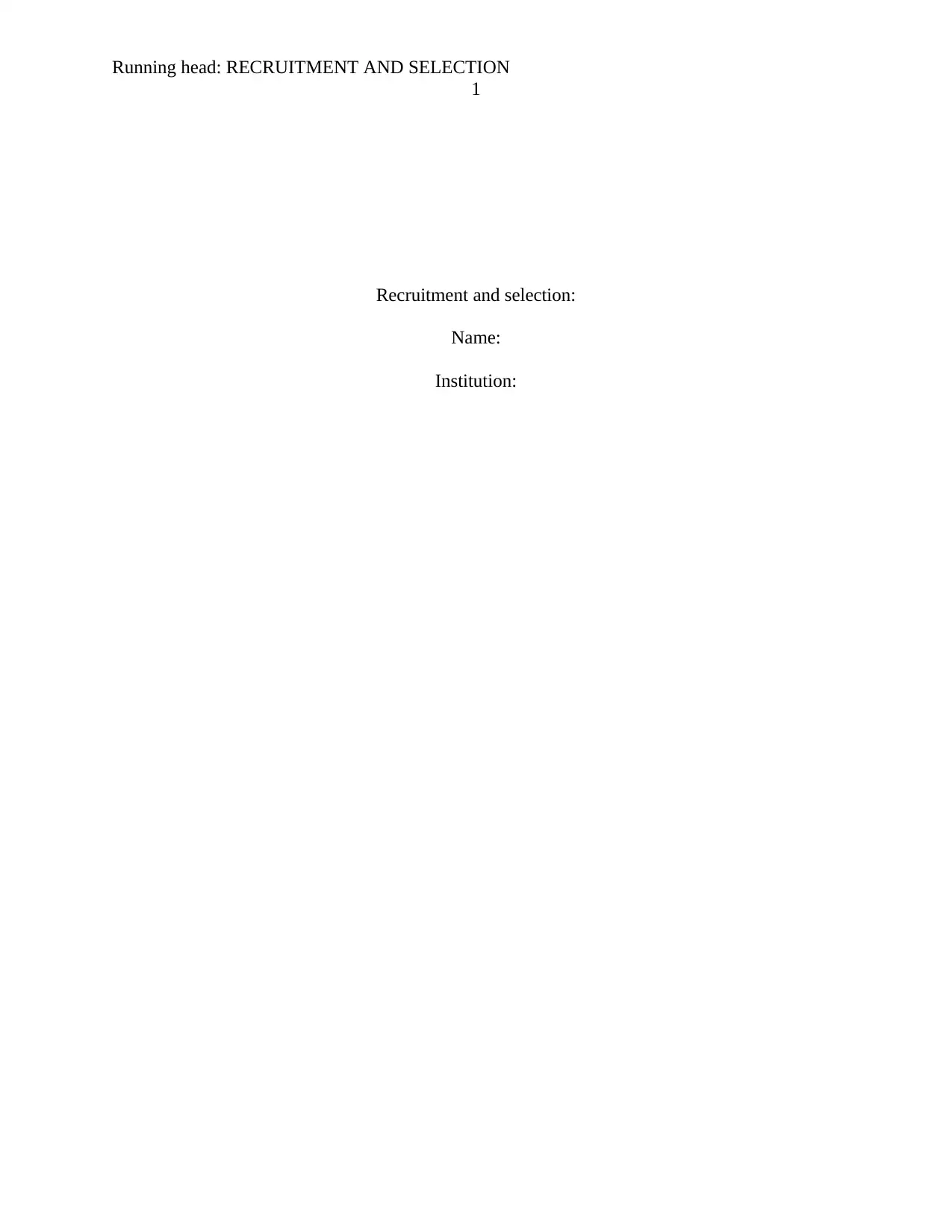
Running head: RECRUITMENT AND SELECTION
1
Recruitment and selection:
Name:
Institution:
1
Recruitment and selection:
Name:
Institution:
Paraphrase This Document
Need a fresh take? Get an instant paraphrase of this document with our AI Paraphraser
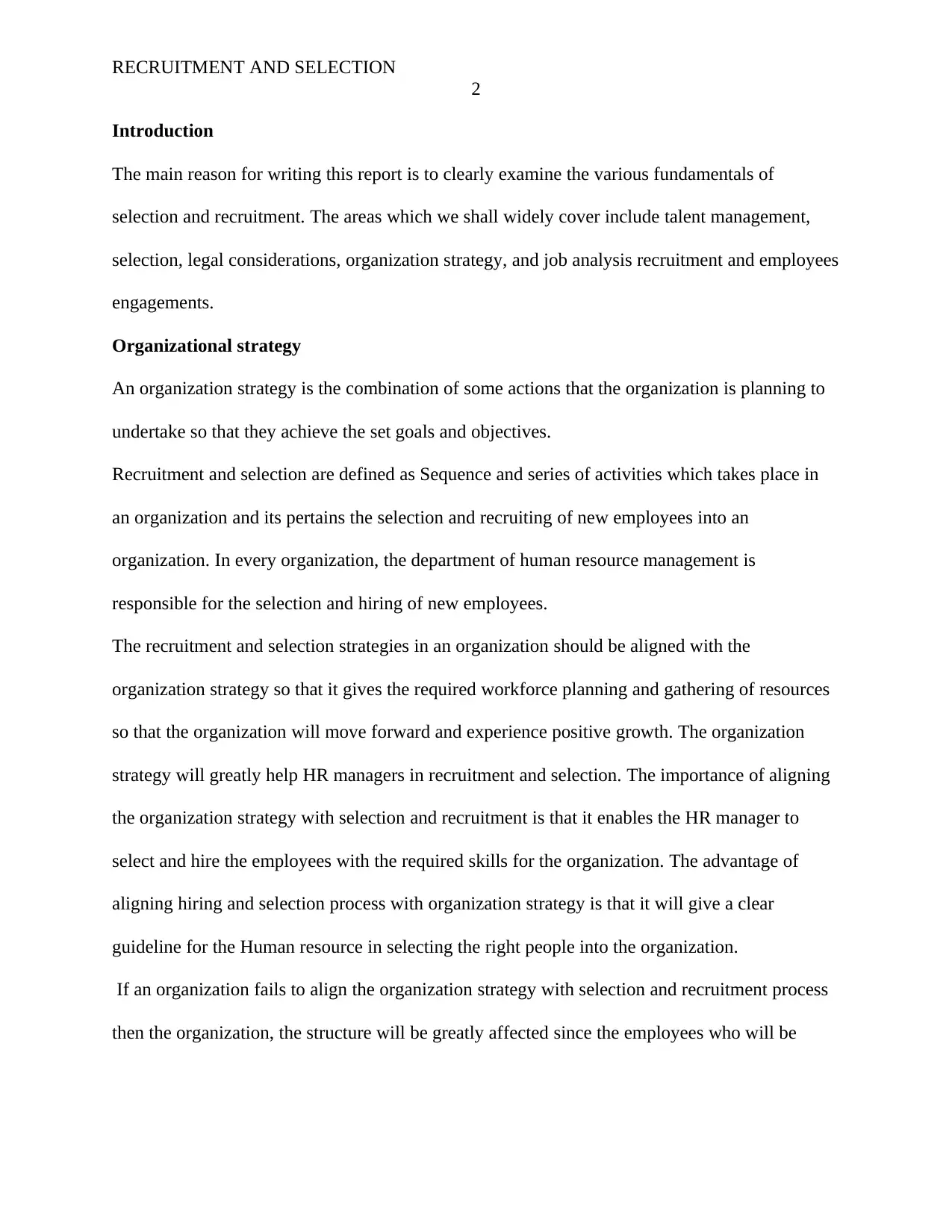
RECRUITMENT AND SELECTION
2
Introduction
The main reason for writing this report is to clearly examine the various fundamentals of
selection and recruitment. The areas which we shall widely cover include talent management,
selection, legal considerations, organization strategy, and job analysis recruitment and employees
engagements.
Organizational strategy
An organization strategy is the combination of some actions that the organization is planning to
undertake so that they achieve the set goals and objectives.
Recruitment and selection are defined as Sequence and series of activities which takes place in
an organization and its pertains the selection and recruiting of new employees into an
organization. In every organization, the department of human resource management is
responsible for the selection and hiring of new employees.
The recruitment and selection strategies in an organization should be aligned with the
organization strategy so that it gives the required workforce planning and gathering of resources
so that the organization will move forward and experience positive growth. The organization
strategy will greatly help HR managers in recruitment and selection. The importance of aligning
the organization strategy with selection and recruitment is that it enables the HR manager to
select and hire the employees with the required skills for the organization. The advantage of
aligning hiring and selection process with organization strategy is that it will give a clear
guideline for the Human resource in selecting the right people into the organization.
If an organization fails to align the organization strategy with selection and recruitment process
then the organization, the structure will be greatly affected since the employees who will be
2
Introduction
The main reason for writing this report is to clearly examine the various fundamentals of
selection and recruitment. The areas which we shall widely cover include talent management,
selection, legal considerations, organization strategy, and job analysis recruitment and employees
engagements.
Organizational strategy
An organization strategy is the combination of some actions that the organization is planning to
undertake so that they achieve the set goals and objectives.
Recruitment and selection are defined as Sequence and series of activities which takes place in
an organization and its pertains the selection and recruiting of new employees into an
organization. In every organization, the department of human resource management is
responsible for the selection and hiring of new employees.
The recruitment and selection strategies in an organization should be aligned with the
organization strategy so that it gives the required workforce planning and gathering of resources
so that the organization will move forward and experience positive growth. The organization
strategy will greatly help HR managers in recruitment and selection. The importance of aligning
the organization strategy with selection and recruitment is that it enables the HR manager to
select and hire the employees with the required skills for the organization. The advantage of
aligning hiring and selection process with organization strategy is that it will give a clear
guideline for the Human resource in selecting the right people into the organization.
If an organization fails to align the organization strategy with selection and recruitment process
then the organization, the structure will be greatly affected since the employees who will be
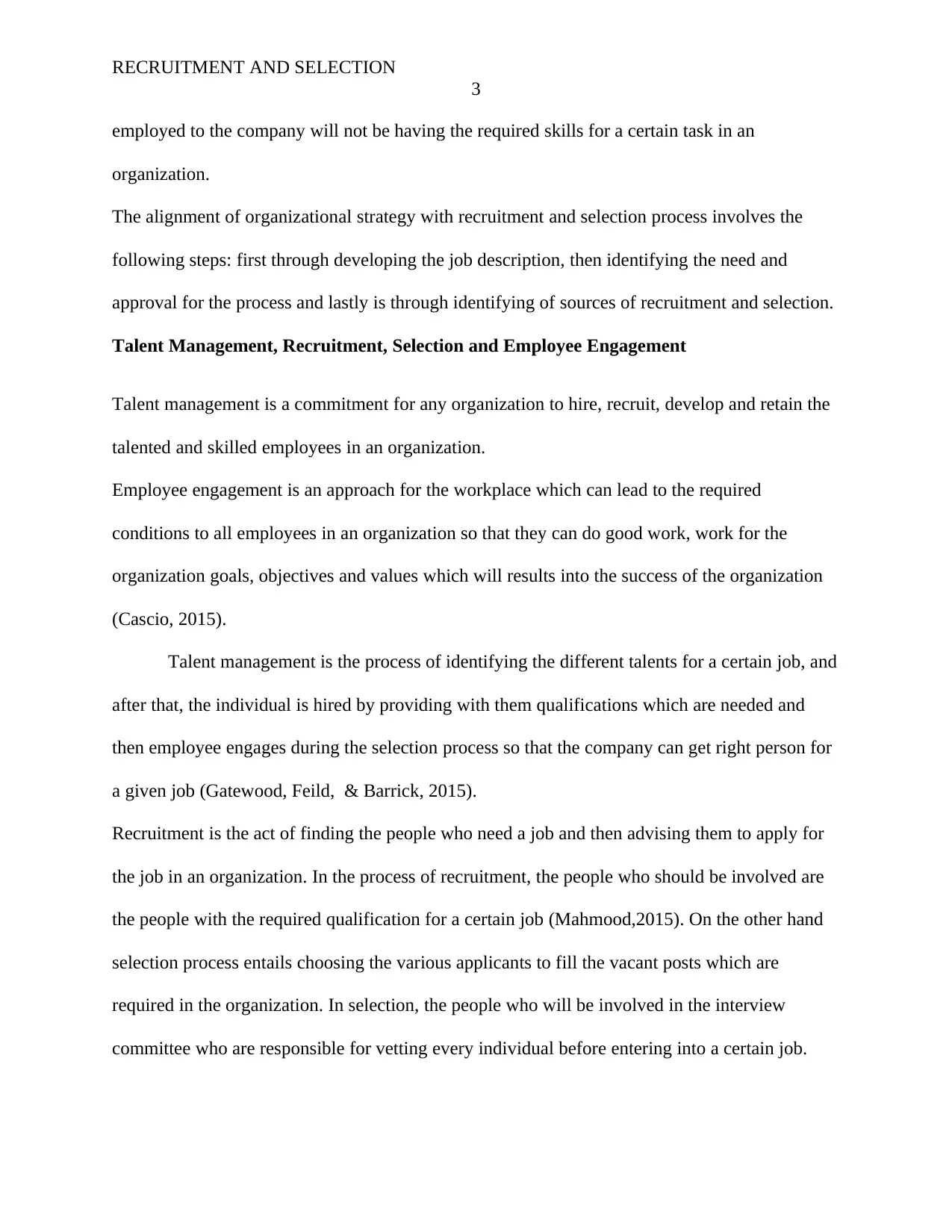
RECRUITMENT AND SELECTION
3
employed to the company will not be having the required skills for a certain task in an
organization.
The alignment of organizational strategy with recruitment and selection process involves the
following steps: first through developing the job description, then identifying the need and
approval for the process and lastly is through identifying of sources of recruitment and selection.
Talent Management, Recruitment, Selection and Employee Engagement
Talent management is a commitment for any organization to hire, recruit, develop and retain the
talented and skilled employees in an organization.
Employee engagement is an approach for the workplace which can lead to the required
conditions to all employees in an organization so that they can do good work, work for the
organization goals, objectives and values which will results into the success of the organization
(Cascio, 2015).
Talent management is the process of identifying the different talents for a certain job, and
after that, the individual is hired by providing with them qualifications which are needed and
then employee engages during the selection process so that the company can get right person for
a given job (Gatewood, Feild, & Barrick, 2015).
Recruitment is the act of finding the people who need a job and then advising them to apply for
the job in an organization. In the process of recruitment, the people who should be involved are
the people with the required qualification for a certain job (Mahmood,2015). On the other hand
selection process entails choosing the various applicants to fill the vacant posts which are
required in the organization. In selection, the people who will be involved in the interview
committee who are responsible for vetting every individual before entering into a certain job.
3
employed to the company will not be having the required skills for a certain task in an
organization.
The alignment of organizational strategy with recruitment and selection process involves the
following steps: first through developing the job description, then identifying the need and
approval for the process and lastly is through identifying of sources of recruitment and selection.
Talent Management, Recruitment, Selection and Employee Engagement
Talent management is a commitment for any organization to hire, recruit, develop and retain the
talented and skilled employees in an organization.
Employee engagement is an approach for the workplace which can lead to the required
conditions to all employees in an organization so that they can do good work, work for the
organization goals, objectives and values which will results into the success of the organization
(Cascio, 2015).
Talent management is the process of identifying the different talents for a certain job, and
after that, the individual is hired by providing with them qualifications which are needed and
then employee engages during the selection process so that the company can get right person for
a given job (Gatewood, Feild, & Barrick, 2015).
Recruitment is the act of finding the people who need a job and then advising them to apply for
the job in an organization. In the process of recruitment, the people who should be involved are
the people with the required qualification for a certain job (Mahmood,2015). On the other hand
selection process entails choosing the various applicants to fill the vacant posts which are
required in the organization. In selection, the people who will be involved in the interview
committee who are responsible for vetting every individual before entering into a certain job.
⊘ This is a preview!⊘
Do you want full access?
Subscribe today to unlock all pages.

Trusted by 1+ million students worldwide
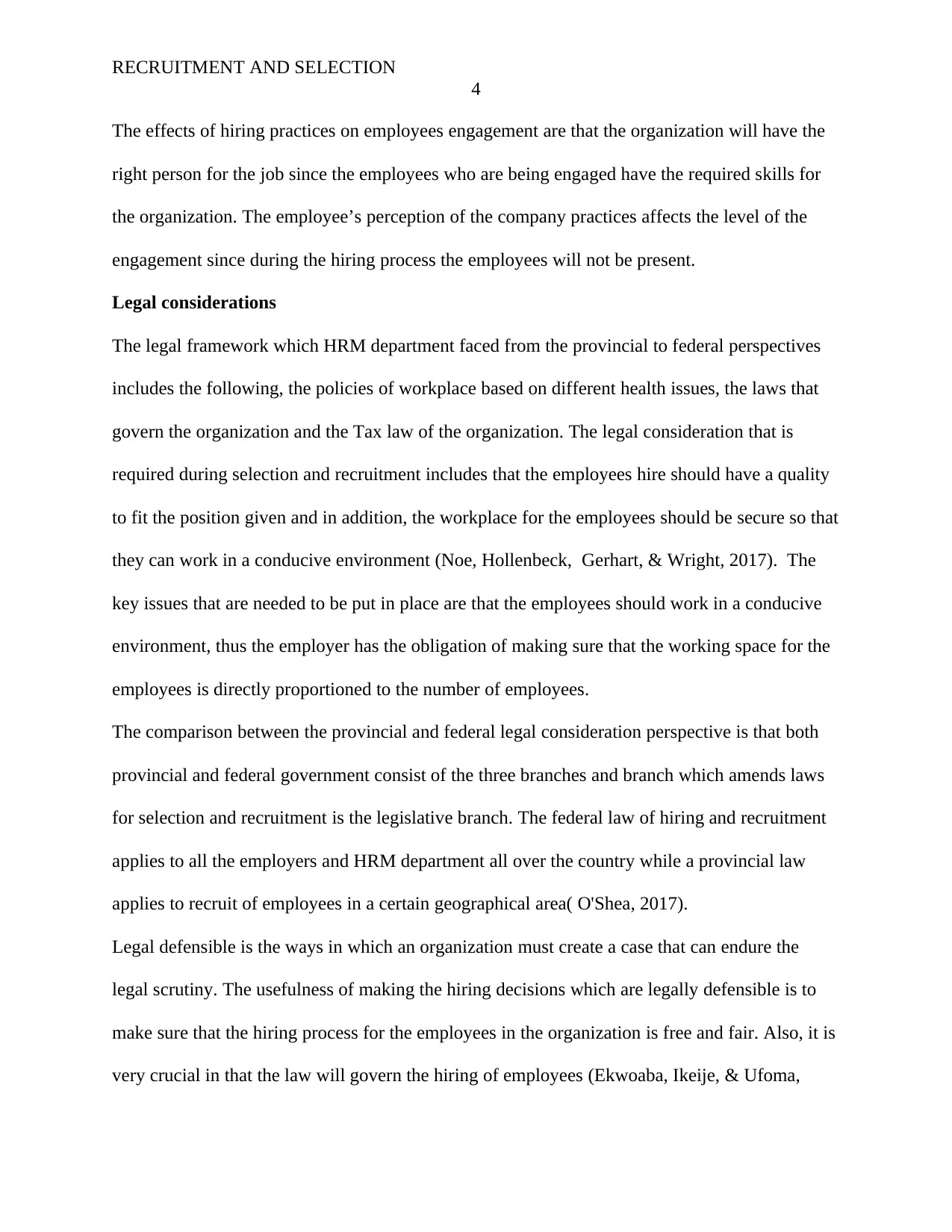
RECRUITMENT AND SELECTION
4
The effects of hiring practices on employees engagement are that the organization will have the
right person for the job since the employees who are being engaged have the required skills for
the organization. The employee’s perception of the company practices affects the level of the
engagement since during the hiring process the employees will not be present.
Legal considerations
The legal framework which HRM department faced from the provincial to federal perspectives
includes the following, the policies of workplace based on different health issues, the laws that
govern the organization and the Tax law of the organization. The legal consideration that is
required during selection and recruitment includes that the employees hire should have a quality
to fit the position given and in addition, the workplace for the employees should be secure so that
they can work in a conducive environment (Noe, Hollenbeck, Gerhart, & Wright, 2017). The
key issues that are needed to be put in place are that the employees should work in a conducive
environment, thus the employer has the obligation of making sure that the working space for the
employees is directly proportioned to the number of employees.
The comparison between the provincial and federal legal consideration perspective is that both
provincial and federal government consist of the three branches and branch which amends laws
for selection and recruitment is the legislative branch. The federal law of hiring and recruitment
applies to all the employers and HRM department all over the country while a provincial law
applies to recruit of employees in a certain geographical area( O'Shea, 2017).
Legal defensible is the ways in which an organization must create a case that can endure the
legal scrutiny. The usefulness of making the hiring decisions which are legally defensible is to
make sure that the hiring process for the employees in the organization is free and fair. Also, it is
very crucial in that the law will govern the hiring of employees (Ekwoaba, Ikeije, & Ufoma,
4
The effects of hiring practices on employees engagement are that the organization will have the
right person for the job since the employees who are being engaged have the required skills for
the organization. The employee’s perception of the company practices affects the level of the
engagement since during the hiring process the employees will not be present.
Legal considerations
The legal framework which HRM department faced from the provincial to federal perspectives
includes the following, the policies of workplace based on different health issues, the laws that
govern the organization and the Tax law of the organization. The legal consideration that is
required during selection and recruitment includes that the employees hire should have a quality
to fit the position given and in addition, the workplace for the employees should be secure so that
they can work in a conducive environment (Noe, Hollenbeck, Gerhart, & Wright, 2017). The
key issues that are needed to be put in place are that the employees should work in a conducive
environment, thus the employer has the obligation of making sure that the working space for the
employees is directly proportioned to the number of employees.
The comparison between the provincial and federal legal consideration perspective is that both
provincial and federal government consist of the three branches and branch which amends laws
for selection and recruitment is the legislative branch. The federal law of hiring and recruitment
applies to all the employers and HRM department all over the country while a provincial law
applies to recruit of employees in a certain geographical area( O'Shea, 2017).
Legal defensible is the ways in which an organization must create a case that can endure the
legal scrutiny. The usefulness of making the hiring decisions which are legally defensible is to
make sure that the hiring process for the employees in the organization is free and fair. Also, it is
very crucial in that the law will govern the hiring of employees (Ekwoaba, Ikeije, & Ufoma,
Paraphrase This Document
Need a fresh take? Get an instant paraphrase of this document with our AI Paraphraser
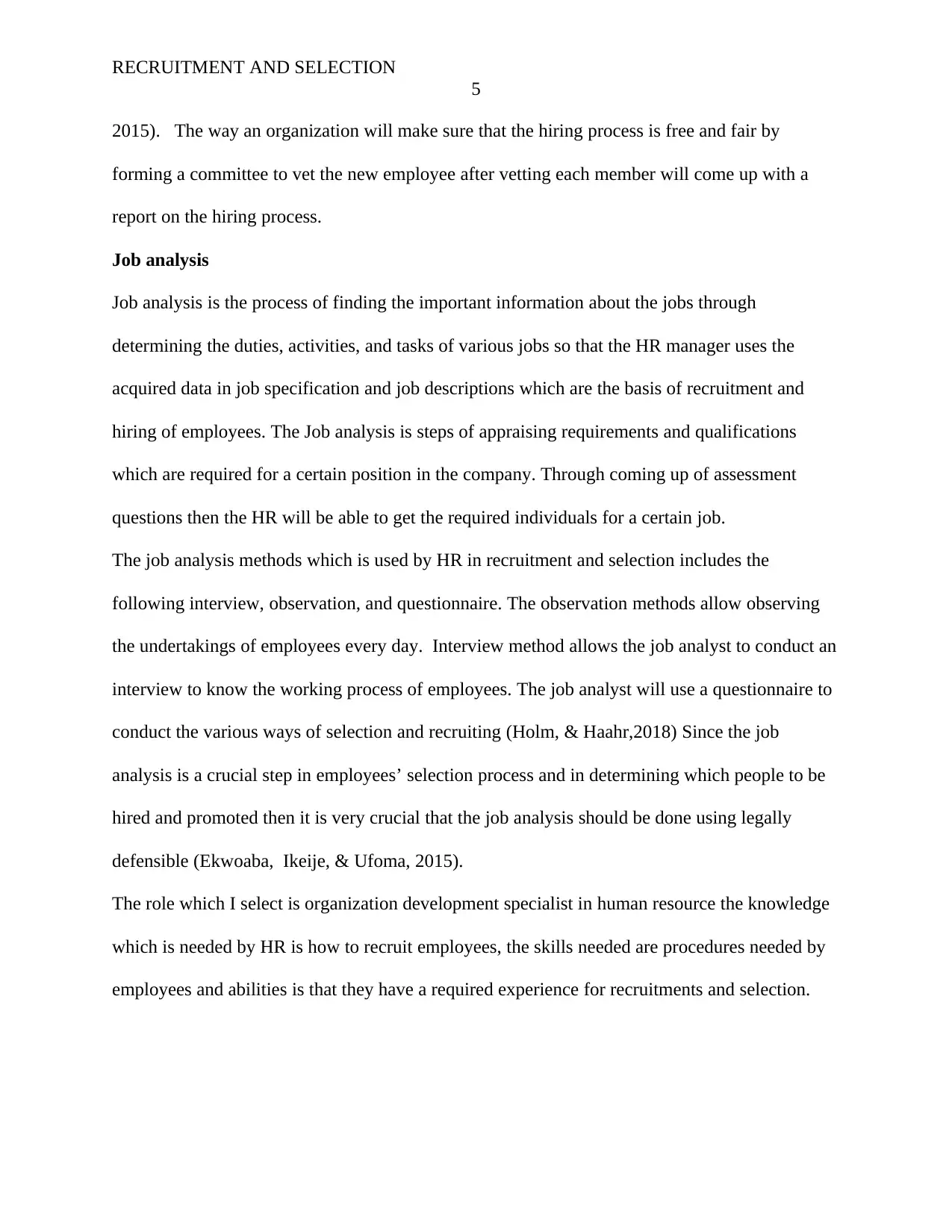
RECRUITMENT AND SELECTION
5
2015). The way an organization will make sure that the hiring process is free and fair by
forming a committee to vet the new employee after vetting each member will come up with a
report on the hiring process.
Job analysis
Job analysis is the process of finding the important information about the jobs through
determining the duties, activities, and tasks of various jobs so that the HR manager uses the
acquired data in job specification and job descriptions which are the basis of recruitment and
hiring of employees. The Job analysis is steps of appraising requirements and qualifications
which are required for a certain position in the company. Through coming up of assessment
questions then the HR will be able to get the required individuals for a certain job.
The job analysis methods which is used by HR in recruitment and selection includes the
following interview, observation, and questionnaire. The observation methods allow observing
the undertakings of employees every day. Interview method allows the job analyst to conduct an
interview to know the working process of employees. The job analyst will use a questionnaire to
conduct the various ways of selection and recruiting (Holm, & Haahr,2018) Since the job
analysis is a crucial step in employees’ selection process and in determining which people to be
hired and promoted then it is very crucial that the job analysis should be done using legally
defensible (Ekwoaba, Ikeije, & Ufoma, 2015).
The role which I select is organization development specialist in human resource the knowledge
which is needed by HR is how to recruit employees, the skills needed are procedures needed by
employees and abilities is that they have a required experience for recruitments and selection.
5
2015). The way an organization will make sure that the hiring process is free and fair by
forming a committee to vet the new employee after vetting each member will come up with a
report on the hiring process.
Job analysis
Job analysis is the process of finding the important information about the jobs through
determining the duties, activities, and tasks of various jobs so that the HR manager uses the
acquired data in job specification and job descriptions which are the basis of recruitment and
hiring of employees. The Job analysis is steps of appraising requirements and qualifications
which are required for a certain position in the company. Through coming up of assessment
questions then the HR will be able to get the required individuals for a certain job.
The job analysis methods which is used by HR in recruitment and selection includes the
following interview, observation, and questionnaire. The observation methods allow observing
the undertakings of employees every day. Interview method allows the job analyst to conduct an
interview to know the working process of employees. The job analyst will use a questionnaire to
conduct the various ways of selection and recruiting (Holm, & Haahr,2018) Since the job
analysis is a crucial step in employees’ selection process and in determining which people to be
hired and promoted then it is very crucial that the job analysis should be done using legally
defensible (Ekwoaba, Ikeije, & Ufoma, 2015).
The role which I select is organization development specialist in human resource the knowledge
which is needed by HR is how to recruit employees, the skills needed are procedures needed by
employees and abilities is that they have a required experience for recruitments and selection.
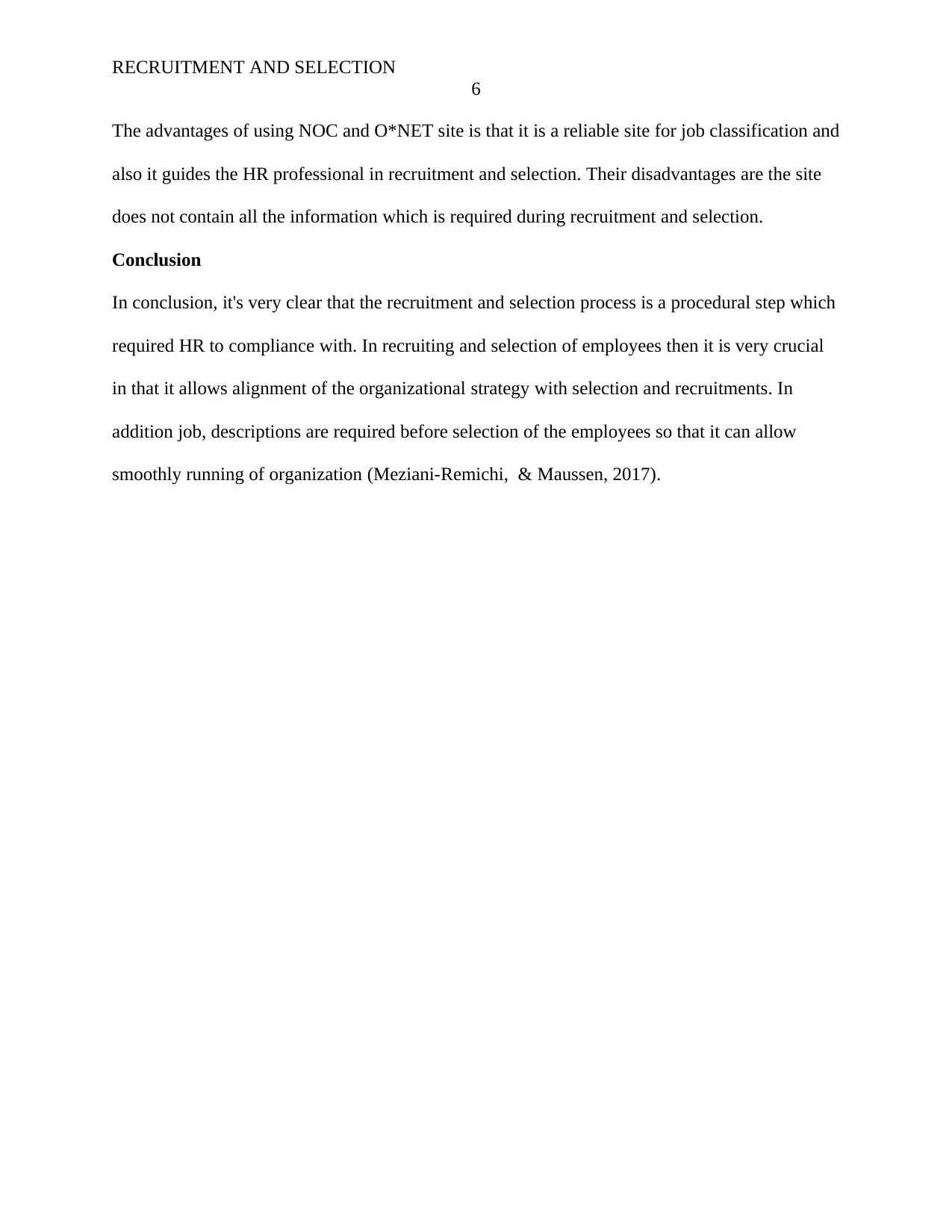
RECRUITMENT AND SELECTION
6
The advantages of using NOC and O*NET site is that it is a reliable site for job classification and
also it guides the HR professional in recruitment and selection. Their disadvantages are the site
does not contain all the information which is required during recruitment and selection.
Conclusion
In conclusion, it's very clear that the recruitment and selection process is a procedural step which
required HR to compliance with. In recruiting and selection of employees then it is very crucial
in that it allows alignment of the organizational strategy with selection and recruitments. In
addition job, descriptions are required before selection of the employees so that it can allow
smoothly running of organization (Meziani-Remichi, & Maussen, 2017).
6
The advantages of using NOC and O*NET site is that it is a reliable site for job classification and
also it guides the HR professional in recruitment and selection. Their disadvantages are the site
does not contain all the information which is required during recruitment and selection.
Conclusion
In conclusion, it's very clear that the recruitment and selection process is a procedural step which
required HR to compliance with. In recruiting and selection of employees then it is very crucial
in that it allows alignment of the organizational strategy with selection and recruitments. In
addition job, descriptions are required before selection of the employees so that it can allow
smoothly running of organization (Meziani-Remichi, & Maussen, 2017).
⊘ This is a preview!⊘
Do you want full access?
Subscribe today to unlock all pages.

Trusted by 1+ million students worldwide
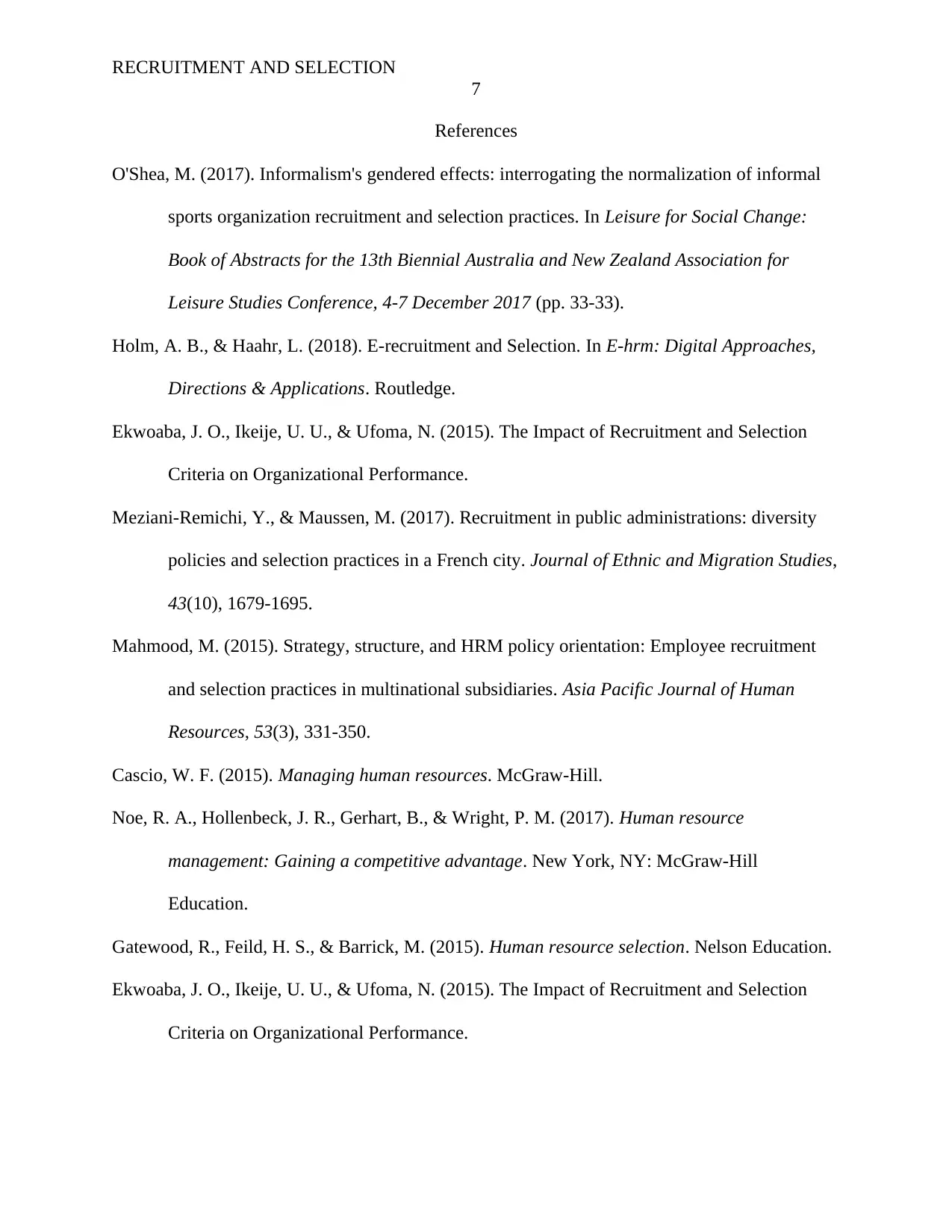
RECRUITMENT AND SELECTION
7
References
O'Shea, M. (2017). Informalism's gendered effects: interrogating the normalization of informal
sports organization recruitment and selection practices. In Leisure for Social Change:
Book of Abstracts for the 13th Biennial Australia and New Zealand Association for
Leisure Studies Conference, 4-7 December 2017 (pp. 33-33).
Holm, A. B., & Haahr, L. (2018). E-recruitment and Selection. In E-hrm: Digital Approaches,
Directions & Applications. Routledge.
Ekwoaba, J. O., Ikeije, U. U., & Ufoma, N. (2015). The Impact of Recruitment and Selection
Criteria on Organizational Performance.
Meziani-Remichi, Y., & Maussen, M. (2017). Recruitment in public administrations: diversity
policies and selection practices in a French city. Journal of Ethnic and Migration Studies,
43(10), 1679-1695.
Mahmood, M. (2015). Strategy, structure, and HRM policy orientation: Employee recruitment
and selection practices in multinational subsidiaries. Asia Pacific Journal of Human
Resources, 53(3), 331-350.
Cascio, W. F. (2015). Managing human resources. McGraw-Hill.
Noe, R. A., Hollenbeck, J. R., Gerhart, B., & Wright, P. M. (2017). Human resource
management: Gaining a competitive advantage. New York, NY: McGraw-Hill
Education.
Gatewood, R., Feild, H. S., & Barrick, M. (2015). Human resource selection. Nelson Education.
Ekwoaba, J. O., Ikeije, U. U., & Ufoma, N. (2015). The Impact of Recruitment and Selection
Criteria on Organizational Performance.
7
References
O'Shea, M. (2017). Informalism's gendered effects: interrogating the normalization of informal
sports organization recruitment and selection practices. In Leisure for Social Change:
Book of Abstracts for the 13th Biennial Australia and New Zealand Association for
Leisure Studies Conference, 4-7 December 2017 (pp. 33-33).
Holm, A. B., & Haahr, L. (2018). E-recruitment and Selection. In E-hrm: Digital Approaches,
Directions & Applications. Routledge.
Ekwoaba, J. O., Ikeije, U. U., & Ufoma, N. (2015). The Impact of Recruitment and Selection
Criteria on Organizational Performance.
Meziani-Remichi, Y., & Maussen, M. (2017). Recruitment in public administrations: diversity
policies and selection practices in a French city. Journal of Ethnic and Migration Studies,
43(10), 1679-1695.
Mahmood, M. (2015). Strategy, structure, and HRM policy orientation: Employee recruitment
and selection practices in multinational subsidiaries. Asia Pacific Journal of Human
Resources, 53(3), 331-350.
Cascio, W. F. (2015). Managing human resources. McGraw-Hill.
Noe, R. A., Hollenbeck, J. R., Gerhart, B., & Wright, P. M. (2017). Human resource
management: Gaining a competitive advantage. New York, NY: McGraw-Hill
Education.
Gatewood, R., Feild, H. S., & Barrick, M. (2015). Human resource selection. Nelson Education.
Ekwoaba, J. O., Ikeije, U. U., & Ufoma, N. (2015). The Impact of Recruitment and Selection
Criteria on Organizational Performance.
Paraphrase This Document
Need a fresh take? Get an instant paraphrase of this document with our AI Paraphraser
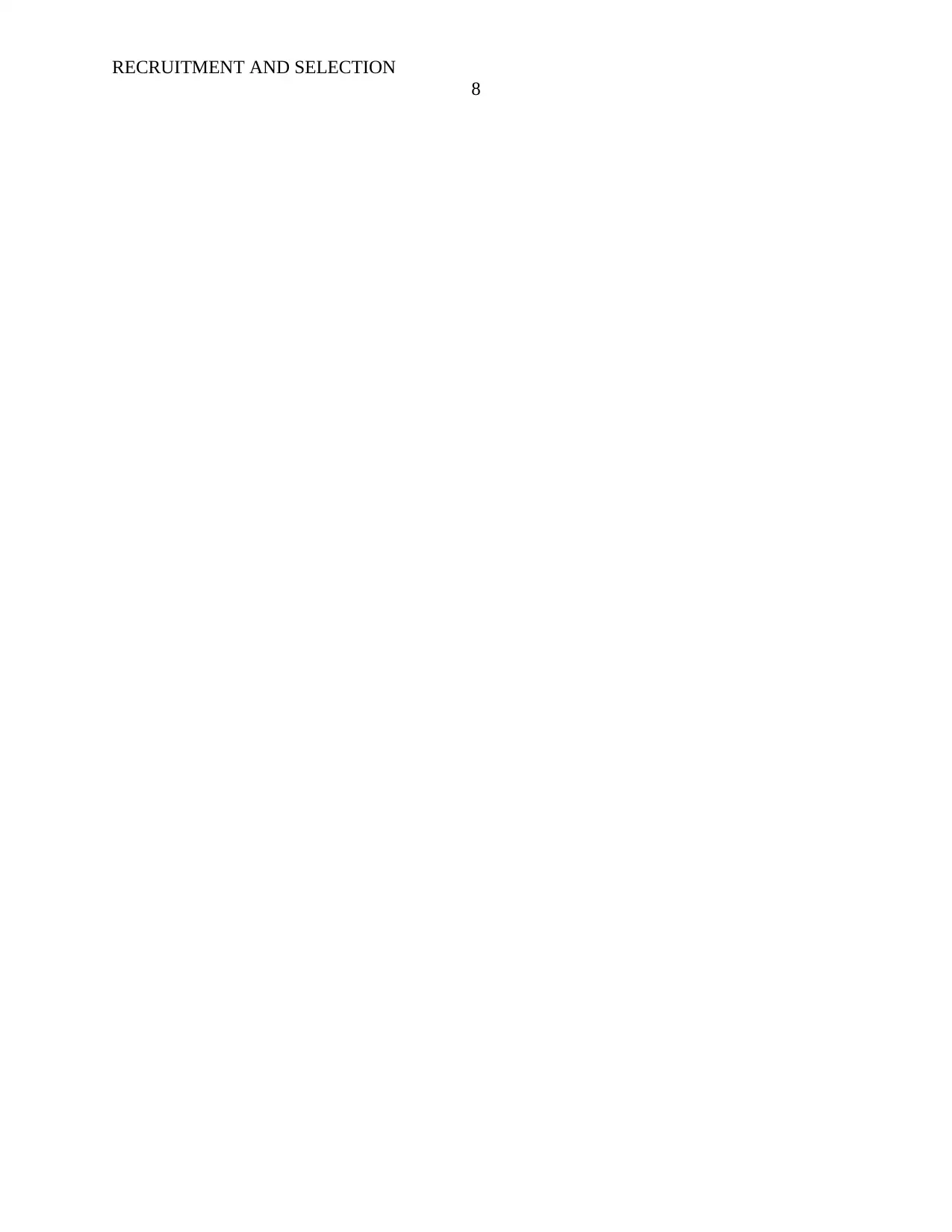
RECRUITMENT AND SELECTION
8
8
1 out of 8
Related Documents
Your All-in-One AI-Powered Toolkit for Academic Success.
+13062052269
info@desklib.com
Available 24*7 on WhatsApp / Email
![[object Object]](/_next/static/media/star-bottom.7253800d.svg)
Unlock your academic potential
Copyright © 2020–2025 A2Z Services. All Rights Reserved. Developed and managed by ZUCOL.




